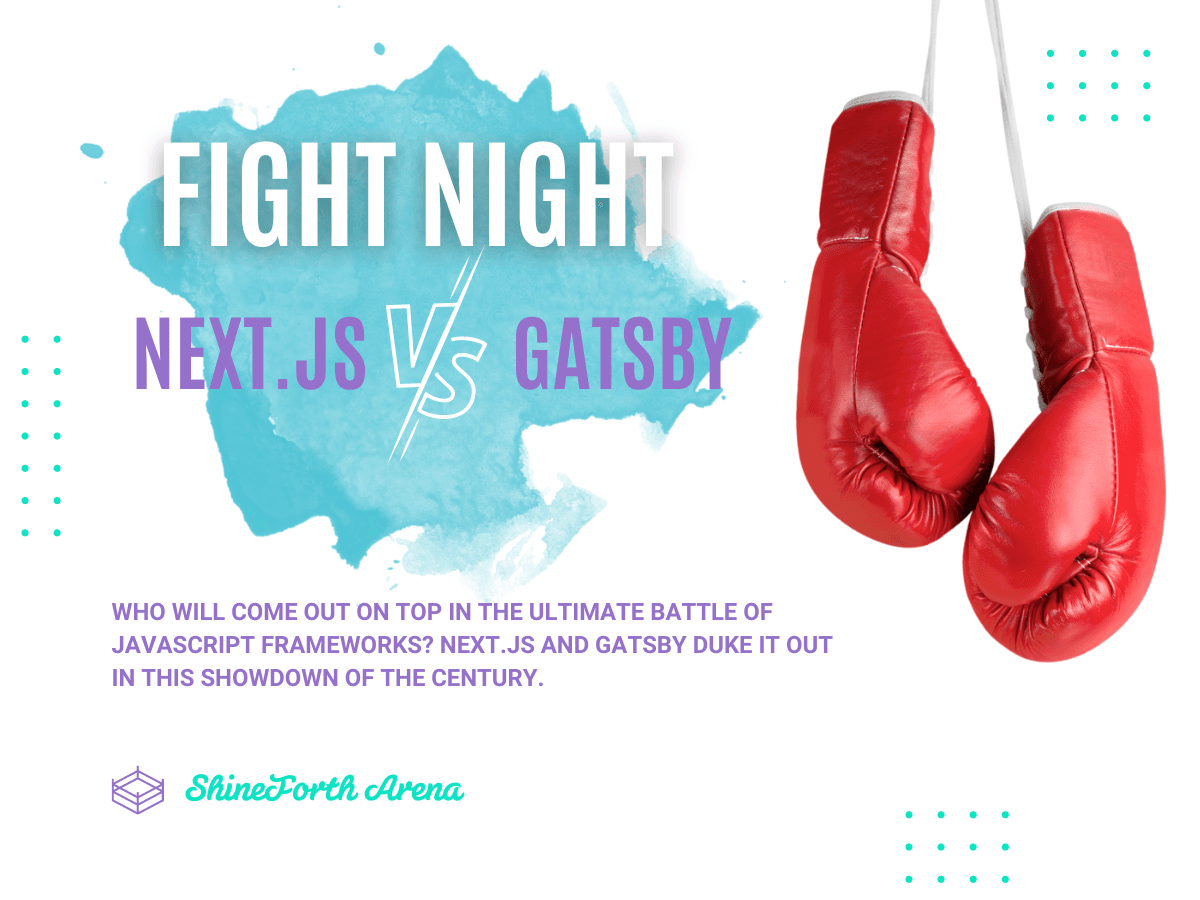Next.js vs Gatsby: The Ultimate Battle of Javascript Frameworks

Welcome to the showdown of the century, where the two biggest contenders in the ring, Next.js and Gatsby, are about to duke it out in a battle of Javascript frameworks. In this corner, we have Next.js, the server-side rendering React application framework. And in the opposite corner, we have Gatsby, the static site and progressive web application framework. Who will come out on top? Let's find out.
Round 1: Setup and Configuration
In the red corner, we have Next.js, a powerful framework known for its simplicity and ease of use. Setting up a Next.js project is a breeze, thanks to its zero-configuration setup. With Next.js, you don't have to spend hours tinkering with build tools or worrying about setting up routing. It comes bundled with everything you need to get started, including server-side rendering (SSR) and automatic code splitting. Plus, Next.js seamlessly integrates with popular libraries like React, making it a favorite among developers.
In the blue corner, we have Gatsby, an equally formidable opponent with a different approach. Gatsby's strength lies in its static site generation capabilities. It excels at creating lightning-fast websites by pre-rendering pages into static HTML and assets, which can be served from a content delivery network (CDN). While Gatsby's configuration requires a bit more initial setup, it offers a highly customizable build process, allowing you to optimize your site's performance to the max.
Round 2: Performance
When it comes to performance, Next.js comes out swinging with its server-side rendering capabilities. By rendering pages on the server, Next.js ensures faster initial page loads and improved search engine optimization (SEO). Additionally, Next.js leverages automatic code splitting, enabling the delivery of only the necessary JavaScript to the client, resulting in smaller bundle sizes and faster subsequent page loads. For applications with dynamic content, Next.js also offers incremental static regeneration, allowing you to update specific pages without rebuilding the entire site.
Gatsby, on the other hand, packs a powerful punch with its static site generation approach. By generating static HTML files, Gatsby sites are incredibly fast, as they can be delivered from a CDN, minimizing server response times. Gatsby's intelligent data fetching strategy allows you to pull data from multiple sources, including APIs and content management systems (CMS), during the build process. This results in optimized data fetching and a highly performant website that's ready to conquer the digital world.
Round 3: Scalability
In terms of scalability, Next.js proves to be a heavyweight contender. With its server-side rendering capabilities, Next.js handles high-traffic scenarios with ease. By generating pages dynamically on the server, it can efficiently distribute the workload and handle a large number of concurrent users. Additionally, Next.js supports serverless deployment options, such as AWS Lambda, enabling automatic scaling and cost efficiency for your applications.
Gatsby, although primarily designed for static site generation, can also scale effectively. By pre-rendering pages into static assets, Gatsby sites can be served efficiently from a CDN, handling high traffic without breaking a sweat. However, Gatsby's strength lies more in delivering highly optimized static sites rather than scaling dynamic applications with heavy server-side processing.
Round 4: Community and Ecosystem
Next.js and Gatsby both have vibrant communities and ecosystems, however there is a clear winner in this round. Next.js benefits from its close integration with the React ecosystem and also the powerful, driving support of Vercel, the company behind Next.js and the provider of innovative Next.js enterprise hosting and platform services. The Next.js community is also continually growing, providing extensive documentation, tutorials, and support, making it easier for developers to get started and find solutions to their problems.
Similarly, Gatsby has built a strong community around its static site generation capabilities. With a thriving plugin ecosystem, Gatsby offers a wide range of pre-built plugins that integrate with various data sources, enabling developers to pull in content from different platforms seamlessly. Gatsby's community is known for its passion and creativity, sharing impressive starter templates and plugins to enhance the development experience.
Round 5: Learning Curve and Flexibility
Next.js aims for simplicity and ease of use, making it a great choice for both beginners and experienced developers. If you're already familiar with React, diving into Next.js will feel like a natural extension of your knowledge. The learning curve is relatively low, and the documentation is comprehensive, providing clear examples and guidelines. Next.js strikes the perfect balance between convention and flexibility, allowing you to customize your application without overwhelming complexity.
Gatsby, while offering immense power and flexibility, requires a bit more investment in terms of learning. Its unique approach to static site generation and data sourcing may take some time to grasp fully. However, Gatsby's documentation and community resources are exceptional, providing ample support and guidance along the way. Once you get the hang of it, Gatsby's flexibility shines through, allowing you to build complex websites and applications tailored to your specific needs.
Verdict:
After an exhilarating battle between Next.js and Gatsby, it's time to announce the winner.
While both frameworks have their strengths and weaknesses, Next.js emerges as the true powerhouse. The support of Vercel coupled with Next.js’s simplicity, server-side rendering capabilities, and scalability make it an excellent choice for a wide range of projects. Whether you're building a static website or a dynamic enterprise application, Next.js offers a robust foundation with optimal performance and a supportive community.
However, let's not forget the strengths of Gatsby either. If your focus is primarily on static site generation and creating lightning-fast websites, Gatsby remains a worthy contender in the JavaScript framework arena.
Ultimately, the choice between Next.js and Gatsby depends on your specific project requirements and development preferences. Now, go forth and unleash the power of Next.js or harness the speed of Gatsby – the choice is yours to make!